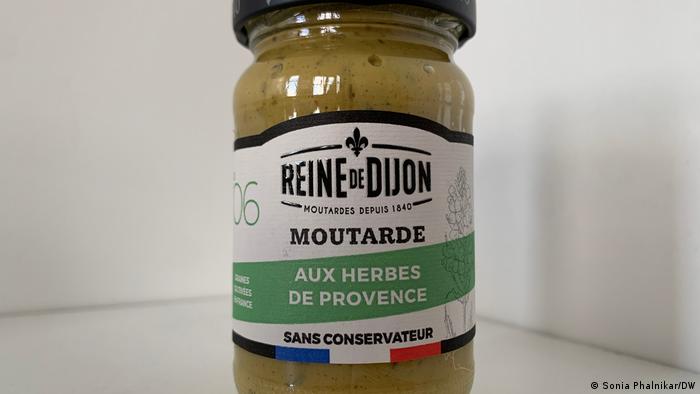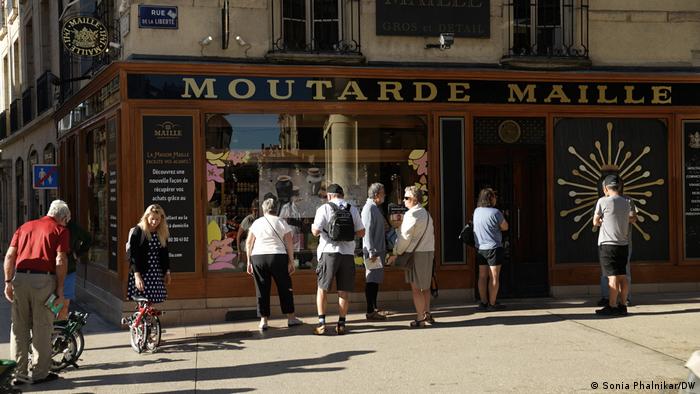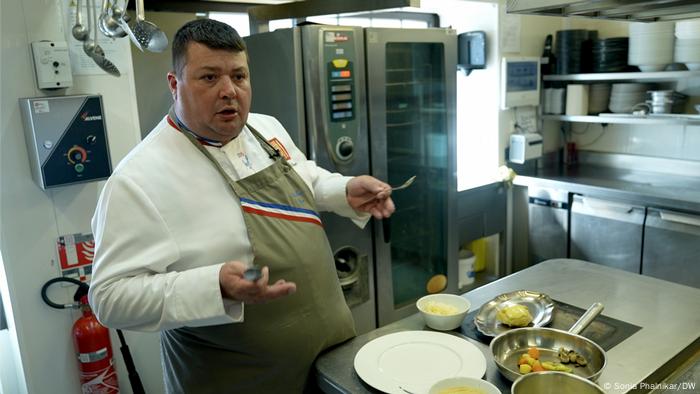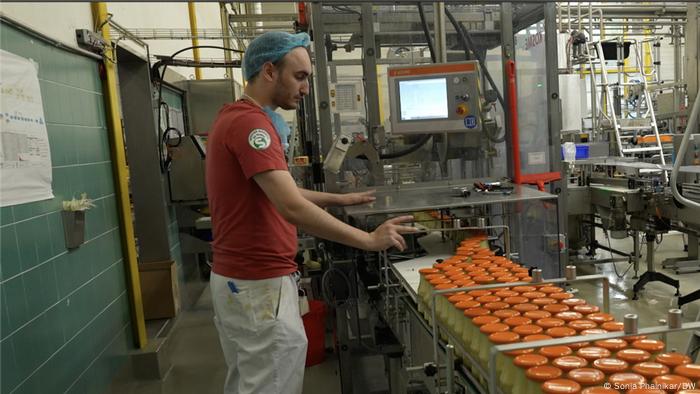In mustard-loving France, shortage of condiment is nothing to sneeze at
France's favorite condiment has disappeared from stores due to a drought in Canada. The shortage has shocked consumers and hobbled the mustard industry. But there's a silver lining to the crisis, Sonia Phalnikar reports.

A rare commodity — France's beloved mustard has all but vanished from
supermarket shelves this year
On a recent morning in Dijon, the capital of Burgundy and famous for the mustard that bears its name, a small group of people gathered at a downtown boutique run by the well-known mustard brand Maille, waiting for the doors to open.
The high-end store normally caters to foreign tourists touring the region's famous vineyards. But on this sunny morning, customers included a number of French nationals like Cecile Martin from northern France, combining a trip to the region with a mission to get their hands on mustard. A sign in the store window said sales were limited to just one jar per household.

Mustard lovers have flocked to this boutique run by mustard brand Maille in Dijon
"There's no mustard to be found in the supermarkets. At least no Djion mustard," Martin told DW, referring to the acidic, nose-tickling condiment made by combining brown mustard seeds with white wine.
The retired teacher rattled off a list of foods she used Dijon mustard in — salad dressings, meat, cold cuts, seafood, sauces, mayonnaise, French fries, sandwiches and even pasta.
"My whole family is a big fan of Dijon mustard. This mustard shortage is a big deal for us," Martin said. "It’s really hard to imagine French cuisine without it.
Using less to cope with scarcity
That love of mustard — at an estimated kilo per person per year, France is the world's largest consumer per capita — explains why the country has been awash in stories this year of consumers hoarding the prized condiment and trying to dodge the one-jar rule in supermarkets. Many restaurants have found inventive ways to cope with the shortage.
Guillame Royer, chef at Au Clos de Napoleon in the Burgundy countryside, told DW that the restaurant normally goes through six to seven kilograms (13-15 pounds) of mustard a month. But, now the establishment has stopped serving mustard on the side to its customers and is rationing the supplies it stocked at the beginning of the crisis.
Royer said he'd even modified the signature dish — a mustard chicken called "le poulet Gaston Gerard" — to ensure that the restaurant doesn't run out of mustard.

Royer adapted his cooking to use less mustard in dishes at a restaurant in Burgundy
"We try and make fewer dishes based on mustard. We've adapted our cooking to use less of it," Royer said. "We try and replace mustard often with a spice, or another dressing or some lemon juice or citrus fruit juice to compensate."
Seeds of crisis sown far away
The reason for the mustard shortage lies far away in Canada, a country that provides a whopping 80% of the brown-grain seeds needed for the French industry. A devastating 2021 heat wave in the provinces of Alberta and Saskatchewan, blamed on climate change, halved production and left French companies scrambling to secure seed supplies.
Russia's invasion of Ukraine also plays a role. Though the two countries are big mustard seed producers as well, they mainly grow the much milder, yellow mustard seed, popular in places like Germany and Hungary, but generally not the brown seeds, or "brassica juncea," used in classic Dijon mustard.

France mainly uses brown-grain mustard seeds and relies heavily
on Canada for supply
The near collapse of exports from Russia and Ukraine has meant that demand has risen heavily for mustard in general, with countries that primarily use yellow mustard seed seeking other types of mustards, including French Dijon.
A big blow to French mustard players
The shortage of seeds has dealt a blow to French mustard makers, most of which are concentrated in the region of Burgundy, which has a history of mustard production dating back centuries. Currently, local seed production accounts for under 20% of supplies to the sector.
"The drought in Canada coupled with an unusually mild winter in France last year meant that harvests in both places were ravaged," Luc Vandermaesen, CEO of Reine de Dijon, told DW. "For us that meant both our main sources of seed supplies dried up."
Reine de Dijon, France's third-largest mustard maker, usually makes about 16,000 tons of mustard a year. The double whammy has meant that the company's overall production is down 25% this year, it's been forced to raise the prices of its mustards and its factory near Dijon has at times been struggling to meet orders.

Production lines at Reine de Dijon have not run at full capacity because of the shortage
Vandermaesen, who said the company is bombarded by calls from people looking for mustard, said the priority was to hold on to the workforce of 165.
"Our biggest problem is the huge uncertainty over supplies. There are weeks when we get some seeds and others when we don't get any at all," Vandermaesen said. "So we're still trying to figure out how to keep our production going."
Bringing production back
Reine de Dijon's factory currently has a few sacks of brown-grain Burgundy seeds. And it's this local resource, Vandermaesen said, that's key to digging themselves out of the crisis.
Vandermaesen is also the president of the Burgundy Mustard Association, which brings together the four big mustard players in the region along with growers. In the wake of the Canadian seed crisis, the companies have embarked on a concerted effort to raise local seed production by paying farmers higher prices — €2,000 ($2,000) per ton of mustard seeds for next year against €900 last year.
In June, the association launched a call for regional farmers to increase land devoted to growing the seeds from 4,000 hectares (9,900 acres) to 10,000 next year.
"For the future, we need to diversify our sources of mustard seeds. We can't put all our eggs in one basket," Vandermaesen said.
Can the plan work?
Fabrice Genin, president of the Association of Burgundy Mustard Seed Producers, and a mustard farmer himself, told DW that raising local production won't be easy.

Genin, who represents Burgundy mustard farmers, says raising
production won't be easy
One problem Burgundy producers face is that the European Union has banned an insecticide long used to combat the black flea beetle, a scourge which has decimated harvests in the past. Another is the unpredictability of the weather and its impacts — last year's unusually mild winter ravaged harvests but this year's French harvest is reported to have been very good.
Genin, however, agreed that the problems in Canada had revived the importance of the sector in the French region. "The plan to raise local production from 20% to 40-50% is a good thing for everyone," he said. "It balances the risks for mustard companies. And we would have production here in the region."
"It wouldn't be huge," he said, "but it's still emblematic of our region because it's Dijon mustard after all."
Edited by: Uwe Hessler
No comments:
Post a Comment